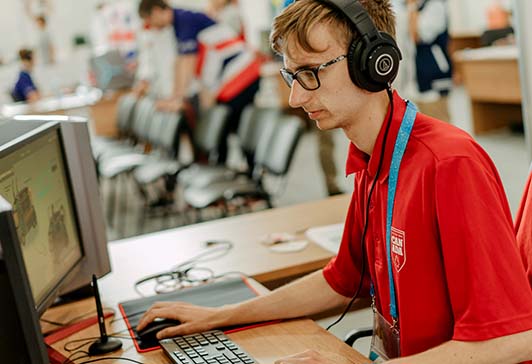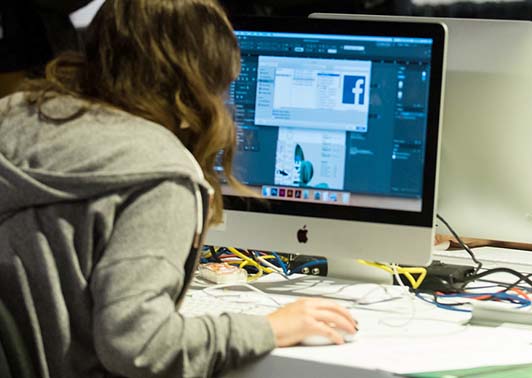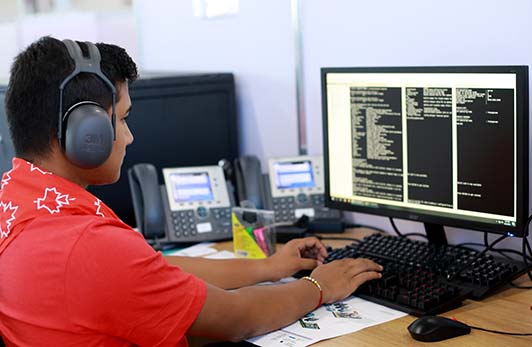Video Production
What is video production?
A career in television and video production offers ample opportunity to move from entry-level positions to a variety of specialties. Newcomers to the business often start out performing duties such as lighting, staging and recording, or operating camera dollies and microphone booms. Mid-level positions include developing and editing film, producing storyboards, and videotaping or audio recording on tape or disc. Experienced and talented individuals may eventually produce, direct or supervise radio and TV programs, films or theatrical performances.
Often viewed as a glamorous profession, most of the work available in this field takes place behind the scenes, involving audio, video, lighting, set design, producing and directing. There is a high demand for skilled workers in these highly technical occupations, which are found in many industries and are continually growing due to changes in technology. Those who are successful have a passion for their work and are willing to work long hours under stressful conditions.
Workers in video production may do the following duties, depending on their role:
- Film, radio and television producers plan, organize and control the various stages and scheduling involved in the production of presentations, motion pictures, television shows and radio programs; engage directors and other production personnel and supervise all technical personnel, and determine the treatment, scope and scheduling of production; maintain production archives and negotiate royalties.
- Directors interpret scripts and direct the mise-en-scène; select and direct the actors, extras and technical crew; advise the cast and crew on the interpretation and delivery of the performance; direct rehearsals, filmings, broadcasts and performances; and confer with crew and specialists throughout production and post-production to achieve desired presentation.
- Choreographers create dances for film, theatre and television performances that convey stories, ideas and moods, and direct rehearsals for dancers to achieve desired interpretation.
- Art directors plan, organize and direct the artistic aspects of motion pictures, stage productions and television shows by overseeing the design of sets, costumes, furnishings and props to create portrayals of period and setting.
- Film editors edit motion picture film and arrange film segments into sequences to achieve continuity and desired dramatic, comedic and thematic effects.
- Record producers plan and co-ordinate the production of musical recordings, direct musicians and singers during rehearsals and recordings and manage technicians involved in duplicating, dubbing and mastering of recordings.
- Directors of photography co-ordinate and direct the photography of motion pictures, supervise camera operators and other crews and determine lighting, lenses, camera angles, backgrounds and other elements to achieve desired visual effect.
HOW TO JOIN THE FIELD
A university degree or college diploma in the performing arts, broadcasting, journalism, business administration, theatre production or film studies and Experience in a technical or production occupation in motion pictures, broadcasting or theatre are usually required.
A university degree or college diploma in music or the recording arts and Experience in a technical or production occupation in the recording arts are usually required.
INDIGENOUS AND REMOTE CONSIDERATIONS
Indigenous and remote communities are catching up to southern Canada when it comes to digital technology and computer skills and industries. Not all communities have access to reliable, affordable internet and service interruptions are all too common. Access to computers at home is not a given for everyone and Elders and even sometimes younger generations lack computer knowledge, although this situation is undergoing some significant changes at the moment. But even those people in Indigenous and remote communities with interest and high-level skills in computers may not have the same access to opportunities to learn about different programs and may face significant bandwidth issues, limiting their ability to learn and develop in this field. Indigenous and remote students may need qualifying courses or need to augment college learning to be successful in this field.
Although with significant improvements currently underway to internet connections in Indigenous and remote communities, careers in this field become more viable and are likely to become more so in years to come.
There are many smaller communities who have recording studios or affiliations with CBC or recording labels that may have the technology to support beginner Video Production training.
DISABILITY CONSIDERATIONS
Since this job may require sitting at a computer for long periods of time, people with visual disabilities may find it challenging. They may require specialized screens. Also, as it may require sitting for long periods of time, people with certain physical disabilities may struggle as well. Accommodations such as standing desks may make the work more comfortable and ergonomic. However, the fact that this work is digital in nature, may make it attractive to people with mobility disabilities, as they may be able to perform most of the work duties from the comfort of their home. People with learning disabilities may require extra support in post-secondary as well as on the job to ensure their success.
Find the right career path for you with our interactive map!
Trouvez le cheminement de carrière qui vous convient grâce à notre carte interactive!
Sample Job Titles
- Special effects technician
- Broadcast engineer
- Recording engineer
- Artistic director
- Producer
- Technical director
Companies and Sectors
- Television stations
- Advertising and marketing companies
- Government services
- Video production companies
- Independent film producers
- Self employed

Video Production and the Skills for Success Program
The key Skills for Success for this career path are:
- Writing
- Collaboration
- Creativity & Innovation




